In the late 1960s, Marx Toys revolutionized children’s playtime with the introduction of the Big Wheel. This low-riding, three-wheeled cycle quickly became a must-have for kids everywhere, setting a new standard for fun on wheels. For many, the Big Wheel was the ride of their childhood.
But just as kids mastered the Big Wheel and started looking for the next thrill, Marx was ready with something even more exciting. Less than a decade later, they unleashed a new kind of wheeled wonder that, while still three-wheeled, was a radical departure from the familiar Big Wheel. This was lower to the ground, steered by two hand levers controlling wide-set rear wheels, and designed for a different kind of riding experience altogether.
This groundbreaking creation was The Green Machine Bike.
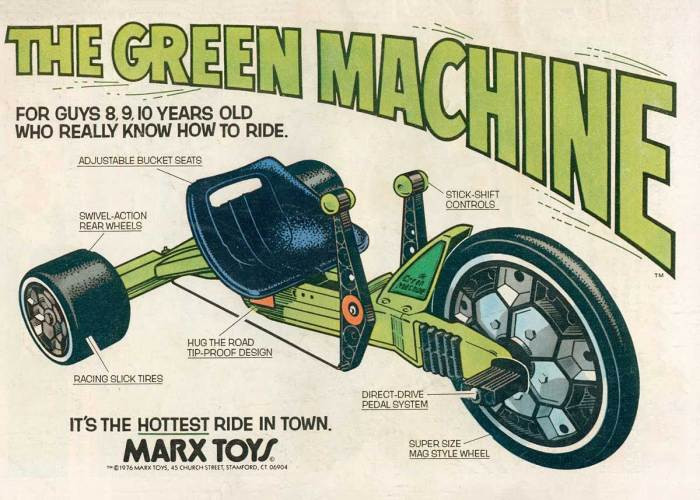 Comic book advertisement for the original Green Machine, highlighting key features like the bucket seat and swivel-action rear wheels.
Comic book advertisement for the original Green Machine, highlighting key features like the bucket seat and swivel-action rear wheels.
As seen in vintage comic book ads from the 1970s, the Green Machine boasted an impressive array of features that set it apart:
- Adjustable Bucket Seat: Designed for comfort and to keep riders securely in place during fast maneuvers.
- Swivel-Action Rear Wheels: The heart of the Green Machine’s unique handling, allowing for spins and drifts.
- Racing Slick Tires: Made for speed and grip on paved surfaces.
- Hug the Road Top-Proof Design: Low center of gravity for stability and safety.
- Direct-Drive Pedal System: Efficient power transfer for quick acceleration.
- Super Size Mag Style Wheel: The iconic large front wheel, contributing to the distinctive look.
- Stick-Shift Control: The dual-handle steering system, providing direct control over the rear wheels.
This wasn’t just a simple upgrade to the Big Wheel; it was a completely different beast. While the Big Wheel was about pedaling around, the Green Machine was about control, speed, and performing thrilling maneuvers. For kids seeking excitement and a departure from the ordinary, the Green Machine was the answer.
Initially, not everyone immediately grasped the appeal. In neighborhoods filled with Big Wheels, the Green Machine stood out, and not always in a way that was immediately understood. Some kids had even moved on to bicycles, making the arrival of a Green Machine seem almost like a step backward in some social circles. Receiving a Green Machine as a gift could be surprising, especially since it was known to be more expensive than the Big Wheel.
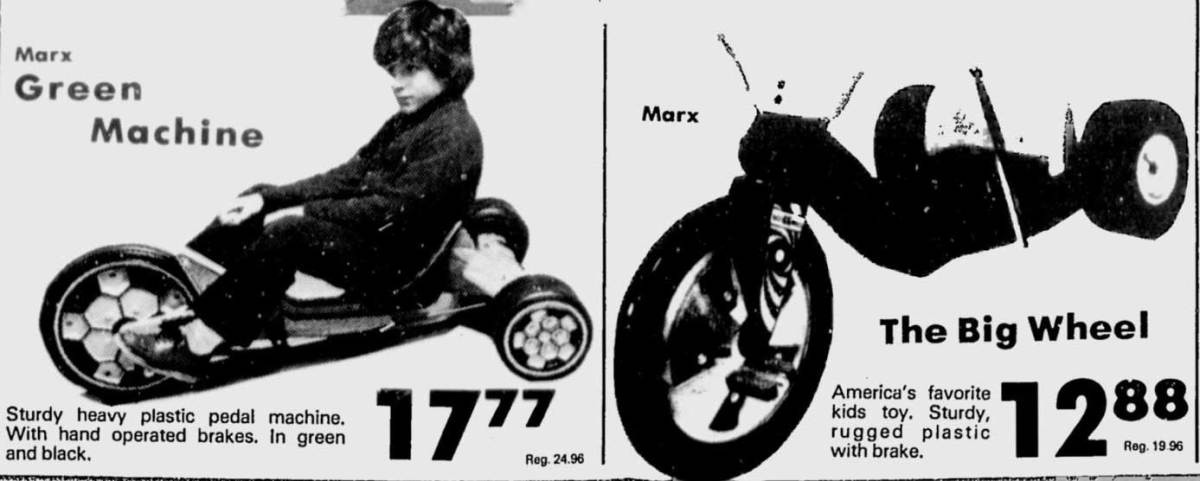 A vintage sales advertisement from 1977 comparing the prices of a Big Wheel and a Green Machine, emphasizing the Green Machine's higher price point.
A vintage sales advertisement from 1977 comparing the prices of a Big Wheel and a Green Machine, emphasizing the Green Machine's higher price point.
Despite the higher cost, some parents, recognizing the “cool factor,” opted for the Green Machine. The original advertisements even highlighted color options beyond just green, mentioning black as an alternative, although finding a purely black Green Machine remains a challenge for collectors today, suggesting a possible misprint in the ad or an extremely rare variant. While the classic green and black combination is what most remember, the idea of a different color, like a hypothetical “Purple Machine,” sparks the imagination.
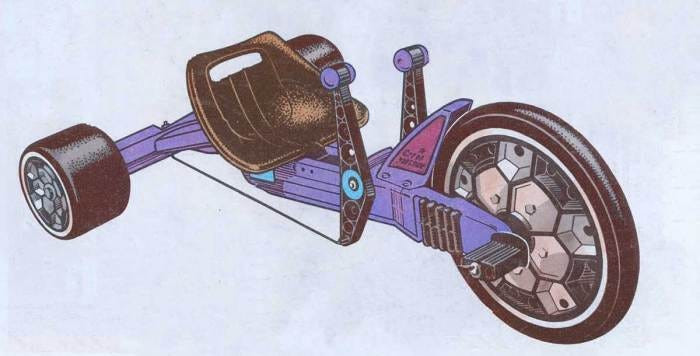 A digitally imagined "Purple Machine" variant, showcasing a custom color scheme on the iconic Green Machine frame.
A digitally imagined "Purple Machine" variant, showcasing a custom color scheme on the iconic Green Machine frame.
Green Machine Variants and Spin-offs
The success and unique design of the original Green Machine led to several variations and inspired similar toys from other manufacturers.
The Green Machine Shadow
In 1979, Marx introduced the Green Machine Shadow, an updated version with a more modern aesthetic. While retaining the core mechanics, the Shadow featured refreshed stickers, a new color scheme, and a distinctive airfoil (spoiler) above the rear wheels, aiming for a sleeker, more futuristic look.
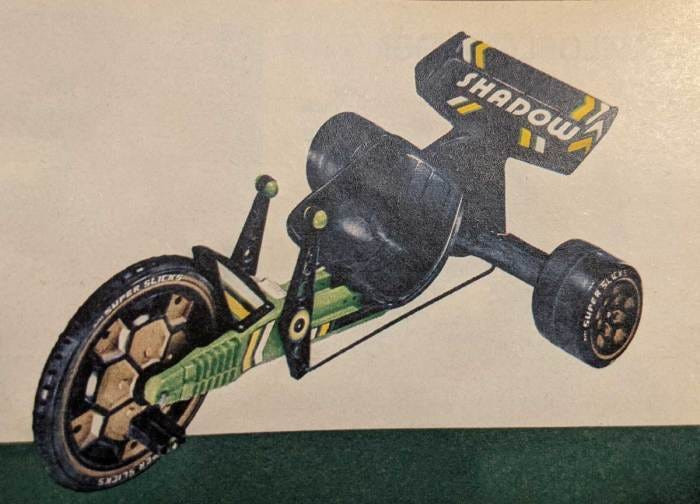 A vintage advertisement for the Green Machine Shadow, highlighting its updated design and rear airfoil.
A vintage advertisement for the Green Machine Shadow, highlighting its updated design and rear airfoil.
The Blue Max Machine
Empire Toys entered the fray with the Blue Max Machine, a direct competitor that closely mirrored the Green Machine’s design. The Blue Max, with its blue and yellow color scheme, offered a similar thrill at a potentially lower price point, making it an attractive alternative for kids who dreamed of a Green Machine but needed a more budget-friendly option.
The Batman Machine
Perhaps the most sought-after variant is the Batman Machine, a 1977 Sears exclusive. This version amplified the cool factor with Batman-themed stickers, a unique color combination likely similar to the Blue Max’s, and a Batman pennant that proudly declared the rider’s superhero allegiance as they cruised down the street.
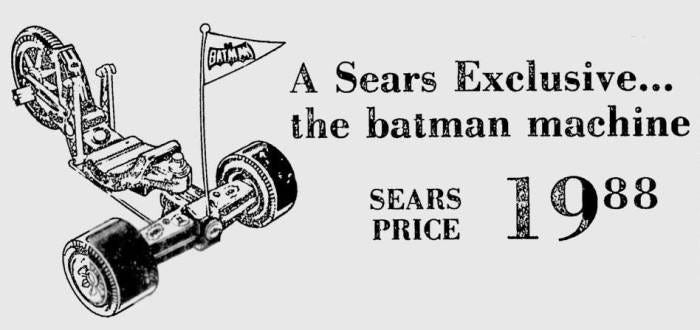 A vintage advertisement showcasing the Sears exclusive Batman Machine, emphasizing its Batman branding and pennant.
A vintage advertisement showcasing the Sears exclusive Batman Machine, emphasizing its Batman branding and pennant.
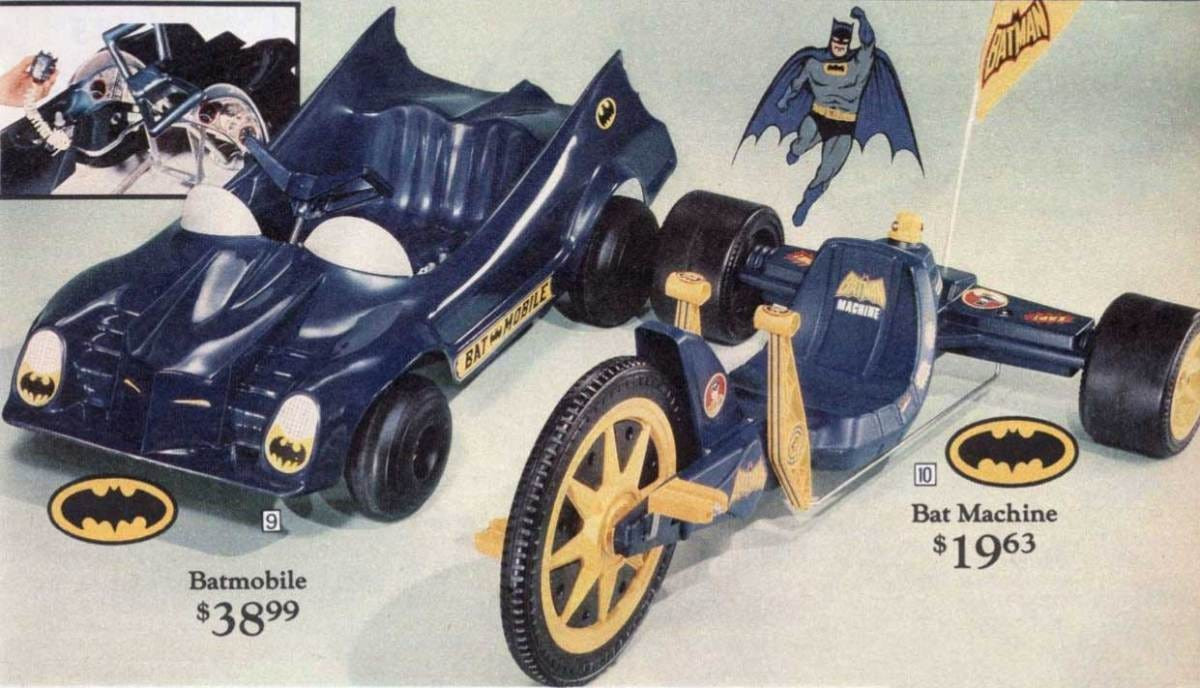 A close-up image of a vintage Batman Machine, highlighting the Batman-themed stickers and overall design.
A close-up image of a vintage Batman Machine, highlighting the Batman-themed stickers and overall design.
Retroist contributor Rob O’Hara’s Batman Machine perfectly exemplifies the allure of this special edition.
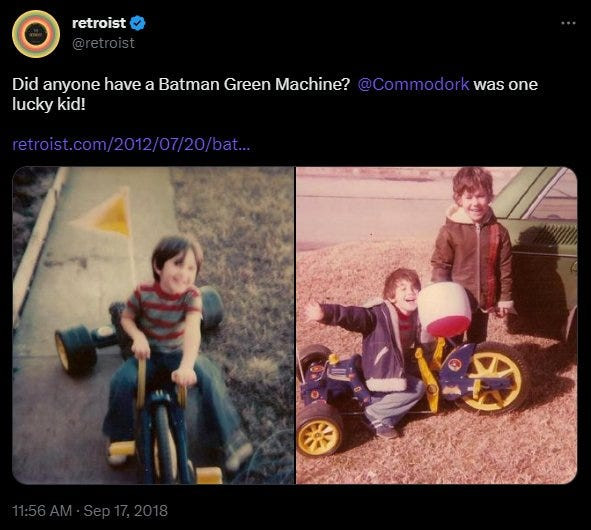 A photograph of a well-preserved vintage Batman Machine, showcasing its iconic design and condition.
A photograph of a well-preserved vintage Batman Machine, showcasing its iconic design and condition.
The Incredible Hulk Machine
Marvel also joined the “Machine” craze with the Incredible Hulk Machine. This variant differentiated itself primarily through its unique green, gold, and purple color scheme and Hulk-themed decals. While perhaps lacking the widespread recognition of the Batman Machine, possibly due to the absence of a Hulk pennant, it remains a distinctive and collectible piece.
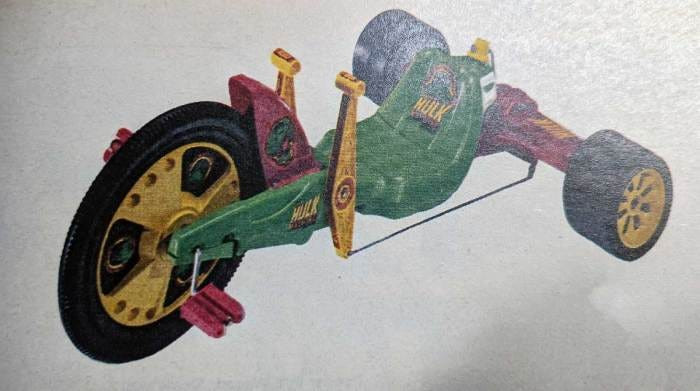 A vintage advertisement or catalog image of the Incredible Hulk Machine, displaying its unique Hulk-themed color scheme.
A vintage advertisement or catalog image of the Incredible Hulk Machine, displaying its unique Hulk-themed color scheme.
The Empire Midnight Rider
Empire Toys also produced the Midnight Rider around 1977, another three-wheeled cycle clearly inspired by the Green Machine. Featuring a cowboy-themed pennant, the Midnight Rider name would later be reused by Empire for Big Wheel-style trikes and pedal cars in the 1980s, though these later versions lacked the cowboy motif.
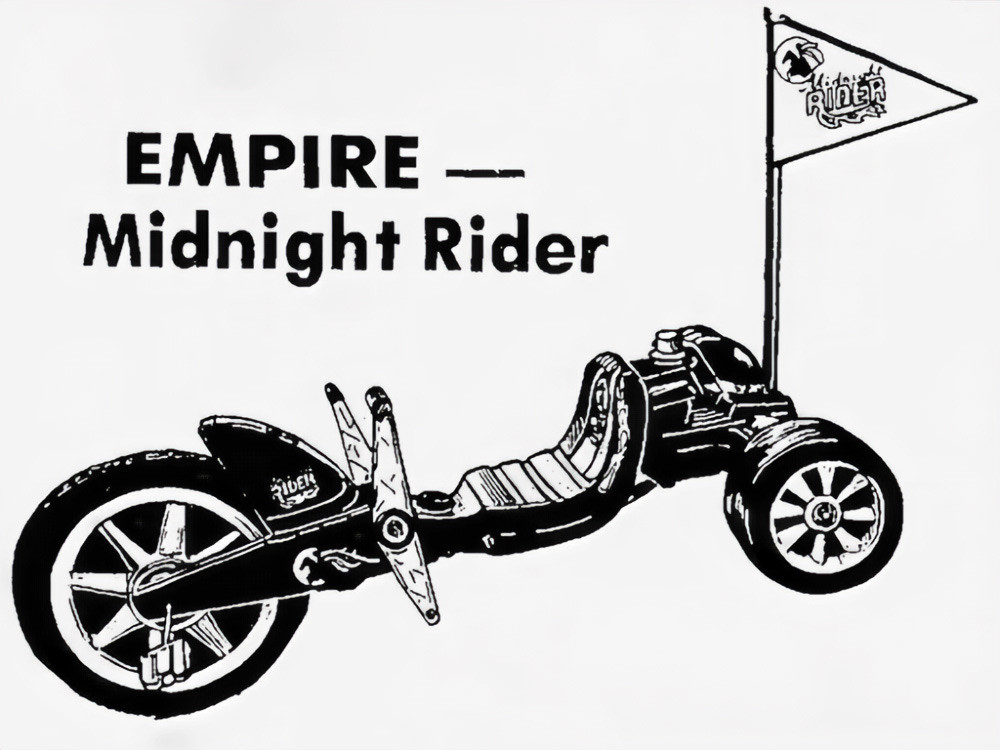 A vintage advertisement for the Empire Midnight Rider, featuring its cowboy-themed pennant and three-wheeled design.
A vintage advertisement for the Empire Midnight Rider, featuring its cowboy-themed pennant and three-wheeled design.
The Green Machine Experience: From Mockery to Mastery
Initially, the Green Machine wasn’t universally embraced. Its unique design, particularly the wide rear wheels, made it somewhat awkward on narrow sidewalks, leading to some initial teasing from neighborhood kids. The Green Machine was different, and sometimes, different is met with skepticism before it’s understood.
However, the true potential of the Green Machine was undeniable once riders discovered its spin-out capabilities. By manipulating the steering levers, a rider could execute impressive 180-degree spins, instantly transforming the Green Machine from an oddity into a source of envy. This newfound trick turned neighborhood races into opportunities for showmanship, where even if you didn’t win, you could still become a “winner” in the eyes of your friends by ending with a dramatic spin.
The Green Machine became the must-have toy, especially for those who craved excitement beyond simply pedaling in a straight line. It was a vehicle for self-expression and skill, turning ordinary streets into personal stunt zones.
Green Machine Advertising and Lasting Legacy
To truly appreciate the Green Machine phenomenon, looking back at its commercials is essential. These ads perfectly captured the energy and thrill associated with the ride, often emphasizing the target demographic of older kids who were ready for more than just basic trikes.
One notable point in retrospect is the modern association of the Green Machine with Huffy. While Huffy produces Green Machines today, many vintage ads and commercials incorrectly attribute the original to Huffy, highlighting the brand’s later acquisition and continued production of the iconic toy. Another interesting aspect of the vintage marketing was the slogan, “For guys 8, 9, 10 years old who really know how to ride.” This slogan, while descriptive, seems to miss the mark in terms of inclusivity. Girls were just as capable and enthusiastic Green Machine riders, and limiting the marketing to boys was a missed opportunity to broaden the toy’s appeal and market reach. Despite any marketing limitations, the Green Machine’s impact on childhood playtime remains undeniable. It was more than just a toy; it was a symbol of freedom, skill, and thrilling fun for a generation.

